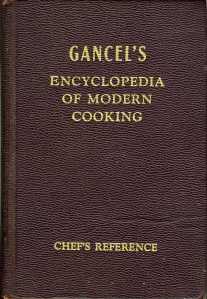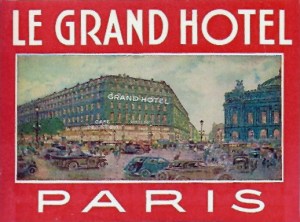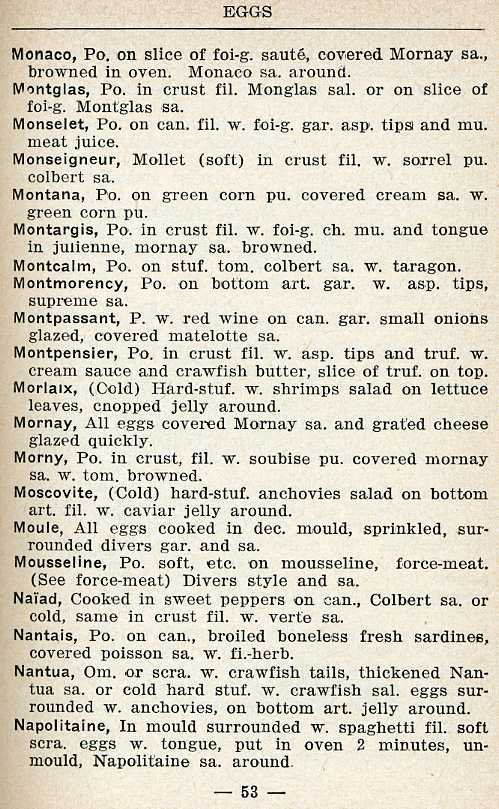 At an antiquarian book show last weekend I picked up a copy of Gancel’s Encyclopedia of Modern Cooking originally published in French in 1918, with an English version in 1920. Gancel’s Encyclopedia was an enlarged and enhanced version of his 1909 Ready Reference of Menu Terms which he compiled to assist waiters in explaining to diners the bewildering number of dishes, mostly in French, found on menus of the best restaurants of that time.
At an antiquarian book show last weekend I picked up a copy of Gancel’s Encyclopedia of Modern Cooking originally published in French in 1918, with an English version in 1920. Gancel’s Encyclopedia was an enlarged and enhanced version of his 1909 Ready Reference of Menu Terms which he compiled to assist waiters in explaining to diners the bewildering number of dishes, mostly in French, found on menus of the best restaurants of that time.
Joseph E. Gancel was a Frenchman who had a long career working in hotels and restaurants in the United States, France, and Belgium, as well as clubs and organizations such as the Brazilian Embassy in Brussels and the Press Club in Paris.
 In 1874, at age 12, Joseph began his culinary apprenticeship in Rennes, France. In the 1880s he worked in the kitchens of European hotels such as Paris’s Grand Hotel and restaurants such as the Café de la Paix and the Moulin Rouge in Paris and the Antwerp branch of the Paris oyster house Rocher de Cancale.
In 1874, at age 12, Joseph began his culinary apprenticeship in Rennes, France. In the 1880s he worked in the kitchens of European hotels such as Paris’s Grand Hotel and restaurants such as the Café de la Paix and the Moulin Rouge in Paris and the Antwerp branch of the Paris oyster house Rocher de Cancale.
 In 1892 he immigrated to the United States with his wife and five children, finding work at the Waldorf-Astoria [pictured], the Plaza, Sherry’s, and others. He worked at many places; I’ve counted 21 and I’m sure the total is greater. When he published his 1920 edition of the Encyclopedia, he was about 58 years old and living in San Francisco where he was a member of Cooks’ Union Local 44. The self-published book, mailed from the author’s lodging house, cost $2.50. I hope he made some money from the book – evidently he had not become rich as a chef.
In 1892 he immigrated to the United States with his wife and five children, finding work at the Waldorf-Astoria [pictured], the Plaza, Sherry’s, and others. He worked at many places; I’ve counted 21 and I’m sure the total is greater. When he published his 1920 edition of the Encyclopedia, he was about 58 years old and living in San Francisco where he was a member of Cooks’ Union Local 44. The self-published book, mailed from the author’s lodging house, cost $2.50. I hope he made some money from the book – evidently he had not become rich as a chef.
 Just how confusing menus could be is indicated by the number of egg dishes included in his 1920 book: 477! To keep the book pocket-size he had to do a lot of abbreviation, leading H. L. Mencken to say, rather wryly, “His terse, epigrammatic style touches the heart.” Readers trying to make sense of the above sample page might like to know that . . .
Just how confusing menus could be is indicated by the number of egg dishes included in his 1920 book: 477! To keep the book pocket-size he had to do a lot of abbreviation, leading H. L. Mencken to say, rather wryly, “His terse, epigrammatic style touches the heart.” Readers trying to make sense of the above sample page might like to know that . . .
art. = artichokes
can. = canapé
dec. = decorated
foi-g. = foie gras
gar. = garnished
po. = poached
pu. = puree
sa. = sauce
sal. = salpicon (a filling of chopped meat, fish, or vegetables)
There are some curiosities in Gancel’s Encyclopedia. Only a handful of Asian menu items are described. He pretty much dismisses Asian cuisine with the sentence, “Culinary art is very poor in China and Japan.” Yet there is room in the book for esoteric dishes such as Sauterelles Rôties, which I must remember never to order. At least I now know how to eat Roast Locusts (“When cold, take off head, wings and tail, eat same as shrimps.”) and how to store them (“Salted locusts can be conserved in a jar, covered with mutton grease.”)
The Encyclopedia also reveals that Gancel was an advocate for kitchen workers. He was quite unhappy with conditions found in most hotel and restaurant kitchens. Noting the stark contrast between magnificent dining rooms and the squalid subterranean areas where meals are prepared, he wrote, “When you see the cooks come out of the basement kitchens, pale and very often rheumatic, it is no wonder that they are so, considering that they have been shut up in such an atmosphere, forced to inhale the gas from the range and the fumes generating in the cooking utensils. . . . Give to these men sanitary, hygienic, well lighted, and ventilated kitchens. Such would be an act of humanity as well as a public necessity.”
I agree.
© Jan Whitaker, 2012


 It's great to hear from readers and I take time to answer queries. I can't always find what you are looking for, but I do appreciate getting thank yous no matter what the outcome.
It's great to hear from readers and I take time to answer queries. I can't always find what you are looking for, but I do appreciate getting thank yous no matter what the outcome.



Pingback: Episode 7: Menu Terms with Jan Whitaker – Station to Station with Joe Pavia
I have a 1920 published book. Says it is the seventh edition (revised and augmented!). Interesting reading. Have had it for years and always enjoy rereading it. Thanks for the information.
I own several copies of this book as the man is my great grandfather. However, I know little about him. Thanks for the interesting article.
Also my half sister’s great grandfather. Her father, my stepfather, was adopted by Henry Cancel. From NJ
I received this very book as a Christmas present from my wife. I found it very interesting, although there are many terms that I feel are terribly out of date and I have to look up.